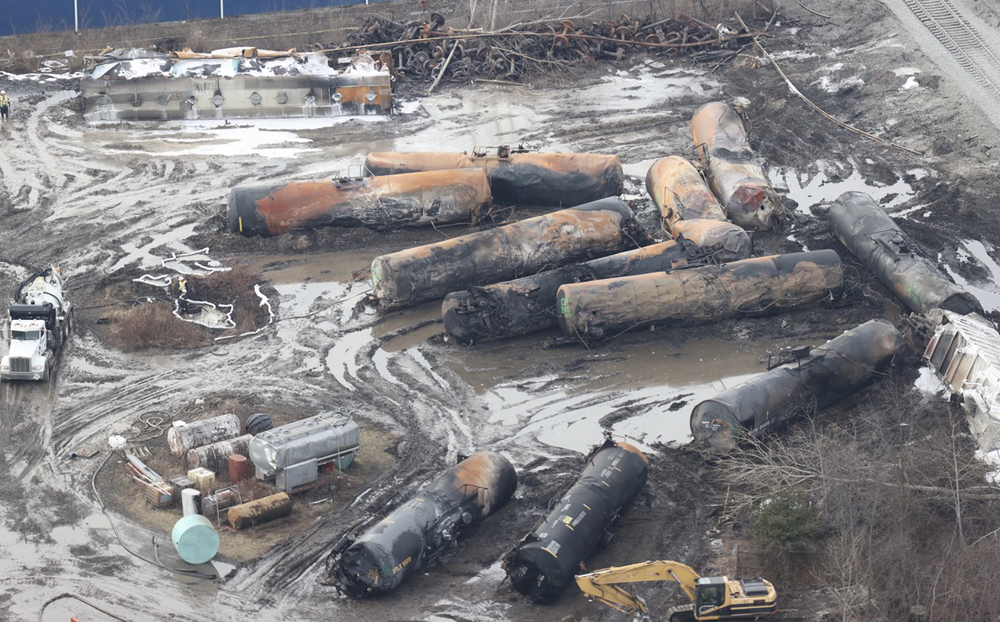
The 31 new safety recommendations that the National Transportation Safety Board made yesterday in response to Norfolk Southern’s hazardous materials wreck in East Palestine, Ohio, have prompted a flurry of responses from the rail industry, lawmakers, and union leaders.
The Feb. 3, 2023, derailment was caused by the failure of a wheel bearing on a covered hopper. The post-derailment fire and initial release of hazardous materials was exacerbated by the use of DOT-111 tank cars, the board said. The NTSB also said it was unnecessary for Norfolk Southern and its contractors to conduct a vent and burn of five tank cars laden with vinyl chloride.
The safety board’s recommendations cover improving the detection of wheel bearing failures, providing first responders with necessary training and hazardous materials information, implementing tougher tank car standards, and tightening operational restrictions on trains carrying hazardous materials.
The NTSB also urged improving communication among railroads, derailment contractors, chemical manufacturers, and first responders before a last-resort decision is made to vent and burn tank cars laden with flammable hazardous materials.
The Association of American Railroads said the industry will learn from the NTSB report to further improve safety.
“NTSB investigators have spent over a year analyzing the derailment’s causes to inform recommendations aimed at preventing similar accidents,” Michael Rush, the AAR’s senior vice president of safety and operations, said in a statement. “Railroads implemented substantial, industry-wide improvements in response to the NTSB’s initial findings. With the final report, railroads will carefully evaluate key learnings and determine next steps to meaningfully advance safety.”
Many of the NTSB findings align with positions the industry has long maintained, the AAR said, including the need to aggressively phase out DOT-111 tank cars from hazmat service. Railroads are reviewing the board’s findings and recommendations to identify “the potential need for additional research surrounding bearing performance or other joint industry efforts.”
Since the NTSB released its preliminary findings, railroads have applied lessons learned and taken significant steps that bolster safety, the AAR said. This includes a multipronged approach to enhance the effectiveness of wayside detectors, improve first responder preparedness, and address tank car standards.
Since East Palestine, railroads have taken three key steps to improve hot bearing detectors, the AAR said. They include increasing the number of HBDs on key routes to reduce spacing between the wayside detectors, establishing a new standard for stopping and inspecting trains when an HBD reading exceeds 170 degrees above the ambient temperature, and adopting a new rule governing how railroads analyze wheel bearing trends.
The AAR has dramatically expanded access to AskRail, which provides first responders with real-time information on railcar contents and how to safely handle them. AskRail information is now available to more than 2.3 million first responders across the U.S. and Canada.
The AAR’s Tank Car Committee is working with shippers to improve standards related to bottom valve protection.
Norfolk Southern said it has already taken steps to provide first responders with immediate availability of train consist information, as well as to encourage its derailment contractors to share information to make emergency response decisions. In addition, the railroad says it has substantially addressed the Federal Railroad Administration recommendations from its 2023 Safety Culture Assessment.
NS said it will move quickly to implement the NTSB’s recommendations. “We resolved not to wait for the NTSB’s final report before taking decisive action,” John Fleps, chief safety officer, said in a statement. “We will continue to build on our strong safety culture through partnership and innovation to be the gold standard of safety for the rail industry.”
The railroad noted steps it has taken since the derailment. Among them:
It’s the first railroad to partner with RapidSOS, a digital platform that connects devices of over 16,000 emergency response agencies to immediately provide first responders with real-time access to train consists, train locations, and emergency response protocols.
Advocating for an expedited phase out of customer-owned DOT-111 tank cars.
NS has installed 187 additional hot bearing detectors, reducing core network average distance between detectors to approximately 12 miles; quadrupled the number of acoustic bearing detectors; and developed and deployed digital train inspection portals.
The railroad also provided first responders with hazardous materials training and will convene a vent and burn workshop to take East Palestine lessons into account for any future scenario where a vent and burn may be necessary.
Ohio’s two U.S. senators — Republican J.D. Vance and Democrat Sherrod Brown — said the NTSB report confirms the need for Congress to pass their bipartisan Rail Safety Act. The measure was introduced in the Senate last year but has languished in committee. Railroads and some Republican leaders have said any legislative response should be based on the NTSB’s recommendations.
“The findings shared by NTSB Chair Homendy today confirm many of my worst fears,” Vance said in a statement. “The derailment and subsequent chemical explosion were preventable tragedies resulting from a series of errors made by Norfolk Southern and its contractors. The NTSB findings also call the Biden Department of Justice’s premature settlement into serious question. Had they waited for these findings to be revealed, they could have secured more for the people of East Palestine. Finally, these findings underscore the need for Congress to pass the Railway Safety Act, which would go a long way to improve our rail safety standards and prevent future disasters like what happened in East Palestine.”
Brown said the NTSB report made it clear that stronger rail safety regulations are necessary.
“Congress needs to pass the Railway Safety Act to enact stronger safety rules and hold the big railroad companies accountable. This report shows that Norfolk Southern’s greed and neglect for public safety is the reason this derailment happened, and the people of East Palestine have suffered the consequences,” he said in a statement.
Eddie Hall, national president of the Brotherhood of Locomotive Engineers and Trainmen, urged Congress to pass the Rail Safety Act.
“The key point is last year’s tragic derailment wasn’t a case of error by a train crew, it was a series of errors made by railroad management,” Hall said in a statement. “The report shows that it is wrong to have long trains travel long distances without any human being inspecting the rail cars.”
He also claimed that the Precision Scheduled Railroading operating model contributed to the derailment by thinning the railroad workforce, focusing on running longer trains, and by reducing thorough inspections of freight cars.
The NTSB did not cite employment levels or train length as contributing factors to the East Palestine derailment. It also said there was no evidence that visual inspections of the train at its origin in Madison, Ill., on the Terminal Railroad Association of St. Louis, or a subsequent inspection on NS at Decatur, Ill., were flawed.
Hall also said that the NTSB report shows railroads are over reliant on wayside detector technology at the expense of inspections by carmen. “Defect detectors can be a great tool to assist car inspections, but they shouldn’t substitute for rail workers conducting thorough inspections,” he said.
Greg Regan, president of the Transportation Trades Department of the AFL-CIO, and Shari Semelsberger, the group’s secretary-treasurer, on Wednesday said the NTSB’s findings and recommendations were confirmation of widespread safety problems that railroad workers have been warning about for years.
“On the whole, the Board’s safety recommendations reinforce our longstanding calls for stronger federal regulations and legislation to improve rail safety,” the union leaders said in a statement. “While the Railway Safety Act does not include every item on our wish list for rail safety, it does address many of the Board’s recommendations and we urge the Senate to take up the legislation. We are hopeful that these recommendations will create a safer freight rail industry for everyone. We thank the NTSB for its steadfast efforts in this investigation and look forward to continuing to work with our federal partners to implement these recommendations and explore additional solutions.”
Note: Updated at 10:22 a.m. on June 27 with comment from TTD officials.














Maybe the FRA should get off their can & make some regulations instead of hoping the RRs will do the right thing.